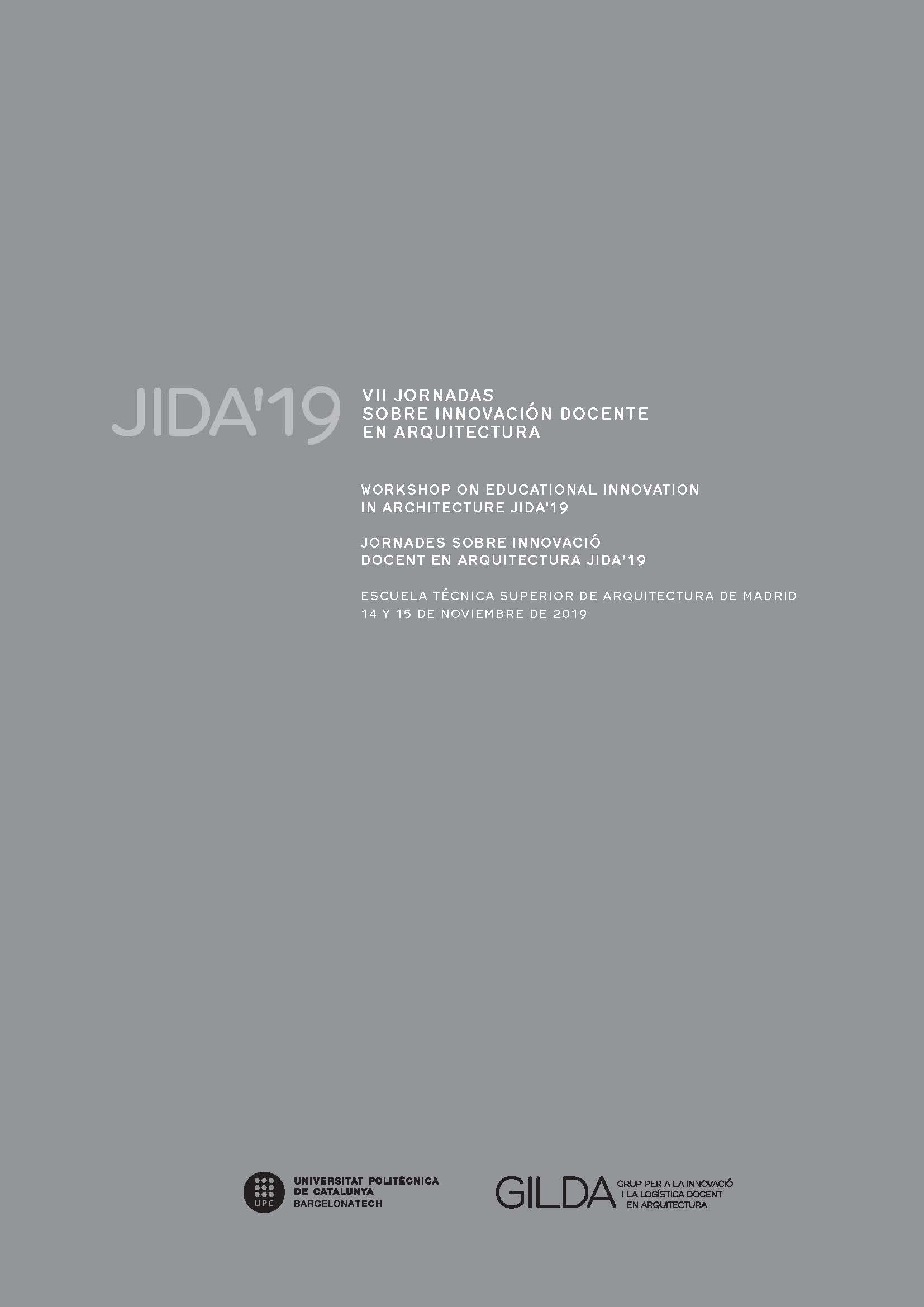Incorporación del blended learning al taller de proyectos arquitectónicos
DOI:
https://doi.org/10.5821/jida.2019.8391Resumen
El blended learning (BL) puede resultar muy útil para mejorar la enseñanza en los tradicionales talleres de Proyectos Arquitectónicos que se imparten en las escuelas públicas españolas. El taller constituye el núcleo educativo de todas las disciplinas vinculadas al diseño en general y a la arquitectura en particular. En la Escuela de Arquitectura de Madrid se utiliza este sistema en todas las unidades docentes del Departamento de Proyectos Arquitectónicos. Sin embargo, que un modelo funcione no implica que no pueda mejorarse. De hecho, tanto los resultados de desempeño académico como las opiniones mostradas por alumnos y docentes indican que algunos aspectos deberían mejorarse. Por otra parte, la irrupción masiva de las tecnologías de la información y la comunicación (TIC) ofrece verdaderas oportunidades de mejora. Este estudio analiza las ventajas y dificultades que plantea una aplicación concreta de blended learning, utilizando Facebook para ampliar las capacidades docentes del tradicional taller de proyectos.
Citas
ALAMMARY, A. y SHEARD, Judy, A. (2014). “Blended learning in higher education: Three different design approachesâ€. Australasian Journal of Educational Technology. 30.
ALMONACID-CANSECO, R. (2017). “Innovación docente en Arquitectura para la generación millennialâ€, GarcÃa-Escudero, D. y BardÃ-Milà , B. (coord.) En JIDA: Textos de Arquitectura, Docencia e Innovación, IV Jornadas sobre Innovación Docente en Arquitectura JIDA’16 (4. 2016. Valencia ETSA-UPV). Barcelona: Publicaciones Acadèmiques Digitals de la UPC, p. 36-41.
AREA, M. y ADELL, J. (2009). “E-Learning: enseñar y aprender en espacios virtualesâ€. La formación del profesorado en la era de Internet, p. 391-424.
BARDà i MILÀ, B, GARCÃA-ESCUDERO, D. (2017). “Dos modelos pedagógicos: conocer versus saber hacerâ€. GarcÃa-Escudero, D. y BardÃ-Milà , B. (coord.) En JIDA: Textos de Arquitectura, Docencia e Innovación, IV Jornadas sobre Innovación Docente en Arquitectura JIDA’16 (4. 2016. Valencia ETSA-UPV). Barcelona: Publicaciones Acadèmiques Digitals de la UPC, p. 16-35.
BARTOLOMÉ, A. (2004). “Blended learning. conceptos básicosâ€. PÃxel-Bit. Revista de Medios y Educación, 23, p. 7-20.
BARTOLOMÉ, A, GARCÃA-RUIZ, R. y AGUADES, I. (2018). “Blended learning: panorama y perspectivasâ€. RIED. Revista Iberoamericana de Educación a Distancia, 21 (1), p. 33-56.
BHOWMIK, J., PHILLIPS, B. y MEYER, D. (2018). “Blended learning in higher education: a case study in postgraduate applied statistics programsâ€. M.A. Sorto, A. White, & L. Guyot (eds), en Looking back, looking forward. Proceedings of the Tenth International Conference on Teaching Statistics (ICOTS10) (julio, 2018, Kyoto, Japon). Voorburg, Paises Bajos: International Statistical Institute.
BINGHAM, N. (1993). “The education of the architectâ€. En proceedings of the 22nd annual symposium of the Society of Architectural Historians of Great Britain. Londres, Society of Architectural Historians of Great Britain.
CARDAK, C.S. y SELVI, K. (2016). “Increasing teacher candidates' ways of interaction and levels of learning through action research in a blended courseâ€. Computers in Human Behavior, 61, p. 488-506.
DZIUBAN, C., GRAHAM, C., MOSKAL, P., NORBERG, A. y SICILIA, N. (2018). “Blended learning: the new normal and emerging technologiesâ€. International Journal of Educational Technology in Higher Education 15/1.
GALLARDO-ECHENIQUE, B. y MARQUÉS-MOLÃAS, L. (2016). “Student communication and study habits of first-year university students in the digital eraâ€. Canadian Journal of Learning & Technology, 42(1).
GARRISON, D. y KANUKA, H. (2004). “Blended Learning: Uncovering Its Transformative Potential in Higher Educationâ€. The Internet and Higher Education, 7, p. 95-105.
GRAHAM, C., WOODFIELD, W y HARRISON, J. (2013). “A framework for institutional adoption and implementation of blended learning in higher educationâ€. The Internet and Higher Education, 18.
GREEN, L. y BONOLLO, E. (2003). “Studio-based teaching: history and advantages in the teaching of designâ€. World Transactions on Engineering and Technology Education, Vol. 2, No. 2, p. 269-272.
GROPIUS, W. (1962). Scope of Total Architecture. Nueva York: Collier Books.
HETERICK, B. y TWIGG, C. (2003). The Learning MarketSpace. Online, retrieved from http://www.center.rpi.edu/LForum/LM/Feb03.html
HESKETT, J. (1997). Industrial Design. Londres: Thames and Hudson.
LYAPINA, I., SOTNIKOVA, E., LEBEDEVA, O., TATIANA, N. y SKVORTSOVA, N. (2019). “Smart technologies: perspectives of usage in higher educationâ€. International Journal of Educational Management. 33.
MEANS, B., TOYAMA, Y., MURPHY, R. y BAKIA, M. (2013). “The effectiveness of online and blended learning: a meta-analysis of the empirical literatureâ€. Teachers College Record, 115.
OLIVER, M. y TRIGWELL, K. (2005). “Can ‘blended learning’ be redeemed?â€. Journal Indexing and Metrics. Volume: 2 issue: 1, p. 17-26. Issue published: March 1.
SALAMA, A. (2015). “Introduction: sustaining the discourse on architectural design pedagogyâ€. Spatial Design Education. New directions for pedagogy in architecture and beyond. New York: Ashgate Publishing. 358 páginas.
SALINAS, J., DE BENITO, B., PEREZ, A. y GISBERT, M. (2018). “Blended learning, más allá de la clase presencial. Blended learning, beyond the classroomâ€. RIED. Revista Iberoamericana de Educación a Distancia, 21 (1), p. 195-213.
SENTIERI, C. (2017). “OIKONET, una plataforma colaborativa: integración en un taller de proyectosâ€. GarcÃa-Escudero, D. y BardÃ-Milà , B. (coord.) En JIDA: Textos de Arquitectura, Docencia e Innovación, IV Jornadas sobre Innovación Docente en Arquitectura JIDA’16 (4. 2016. Valencia ETSA-UPV) Barcelona: Publicaciones Acadèmiques Digitals de la UPC, p. 152-173.
SPRING, K., GRAHAM, C. y HADLOCK, C. (2016). “The Current Landscape of International Blended Learningâ€. International Journal of Technology Enhanced Learning, Volumen 8, Issue 1.
TUTALENI I. y ALANA, P. (2019). “Student Perceptions on the Role of the Classroom Environment on Computer Supported Collaborative Learning“. TechTrends. March 2019, Volume 63, Issue 2, p. 179-187.
TWIGG, C. (2003). “Improving learning and reducing costs: new models for online learningâ€. Educause Review Volume, 38, Number 5.






















